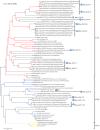Coronaviruses in bats from Mexico
- PMID: 23364191
- PMCID: PMC3709589
- DOI: 10.1099/vir.0.049759-0
Coronaviruses in bats from Mexico
Abstract
Bats are reservoirs for a wide range of human pathogens including Nipah, Hendra, rabies, Ebola, Marburg and severe acute respiratory syndrome coronavirus (CoV). The recent implication of a novel beta (β)-CoV as the cause of fatal respiratory disease in the Middle East emphasizes the importance of surveillance for CoVs that have potential to move from bats into the human population. In a screen of 606 bats from 42 different species in Campeche, Chiapas and Mexico City we identified 13 distinct CoVs. Nine were alpha (α)-CoVs; four were β-CoVs. Twelve were novel. Analyses of these viruses in the context of their hosts and ecological habitat indicated that host species is a strong selective driver in CoV evolution, even in allopatric populations separated by significant geographical distance; and that a single species/genus of bat can contain multiple CoVs. A β-CoV with 96.5 % amino acid identity to the β-CoV associated with human disease in the Middle East was found in a Nyctinomops laticaudatus bat, suggesting that efforts to identify the viral reservoir should include surveillance of the bat families Molossidae/Vespertilionidae, or the closely related Nycteridae/Emballonuridae. While it is important to investigate unknown viral diversity in bats, it is also important to remember that the majority of viruses they carry will not pose any clinical risk, and bats should not be stigmatized ubiquitously as significant threats to public health.
Figures



References
-
- Arita H. T., Ortega J. (1998). The Middle-American bat fauna: conservation in the Neotropical-Nearctic border. In Bat Biology and Conservation, pp. 295–308. Edited by Kunz T. H., Racey P. A. Washington, DC: Smithsonian Institution Press.
-
- Carrington C. V., Foster J. E., Zhu H. C., Zhang J. X., Smith G. J., Thompson N., Auguste A. J., Ramkissoon V., Adesiyun A. A., Guan Y. (2008). Detection and phylogenetic analysis of group 1 coronaviruses in South American bats. Emerg Infect Dis 14, 1890–1893. 10.3201/eid1412.080642 - DOI - PMC - PubMed
Publication types
MeSH terms
Substances
Associated data
- Actions
- Actions
- Actions
- Actions
- Actions
- Actions
- Actions
- Actions
- Actions
- Actions
- Actions
- Actions
- Actions
- Actions
- Actions
- Actions
- Actions
- Actions
- Actions
- Actions
- Actions
- Actions
- Actions
- Actions
- Actions
- Actions
- Actions
- Actions
- Actions
- Actions
Grants and funding
LinkOut - more resources
Full Text Sources
Other Literature Sources

